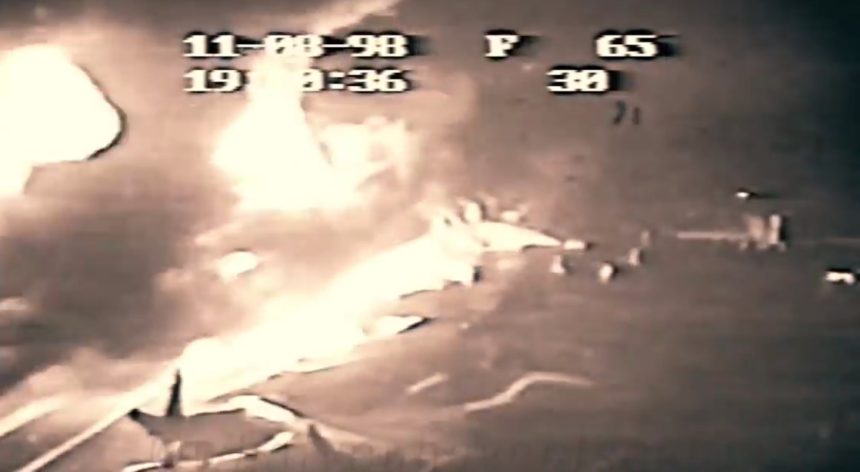Beware, graphic footage ahead.
The clip below was filmed aboard USS Enterprise off the U.S. East Coast on Nov. 8, 1998 when an EA-6B Prowler, BuNo. 163885/’AC-503′ of VAQ-130, US Navy, based at Whidbey Island, Washington, collided with an S-3B Viking, BuNo. 159733 of VS-22, US Navy.
As the tragic footage shows, the Viking was struck on the deck by the EA‑6B during night landing practice: you can clearly see the S-3 perform the arrested landing and then Prowler touch down on a “foul-deck” (this is the technical term used when there is traffic on flight deck and approaching aircraft would have to be waved-off). Based on reports, the Prowler was waved-off when it was too late and could not complete the go around.
Both aircrews ejected: according to details made available by the user who posted the video “one of the Viking crew members was quickly located entangled by his parachute in the antennae complex of the carrier’s command island. The other Viking crew member was scooped up from the frigid ocean water not long thereafter. But the night wasn’t a good one for the Prowler crew. All four aboard – Lieutenant Commander Kurt W. “Gumby” Barich, 35, of Oak Harbour, Washington, and Lieutenants – Junior Grade Brendan J. “Duff” Duffy, 27, of Annapolis, Maryland; Charles E. “Woody” Woodard, 26, of Herndon, Virginia; and Meredith C. “Pop” Loughran, 26, of Sanston, Virginia; were lost. The body of LtJG Duffy was found that night, but even with the assistance of two other Navy ships in the search the remaining three were never found.”
Additional details about that night 20 years ago were provided in the comment section of the Youtube video. Here’s what user bombcat91 wrote: “An interesting testimony from John E. Little, an Aviation Structural Mechanic who was in service that night. We were just changing over from day time ops, to night ops. I had just dipped below deck to change my goggle insert from tinted to a clear one. I was on the starboard side, towards the aft of the ship. I could hear the EA-6B on approach and almost at once I heard the EA-6B go to full power and then a big ‘Clank’ and ‘Whoosh’.” […] “As I looked up the entire ship was orange from the fireball. At first everyone was confused as what to do because there were allot of aircraft with their engines still turning, and you can’t just run up on the deck. The plane captains were furiously trying to get their pilots shut down and out of their aircraft.” […] “Once I was able to get to the back side of the island, I could see the fire crew battling the flames, I ran and jumped on the nearest AFFF hose and we took turns at the nozzle. The heat was so intense just standing there you felt like you were cooking. Our S-3 still had both engines running even after the pilots ejected and it had come to rest up against some F-18s that were badly damaged from the fire. One of our AD engine mechs got the door to the S-3 open and shut the aircraft down. After we moved the aircraft to the elevators we had to chip the molten aluminum off of the flight deck as there were aircraft stacked and ready to land.”
Arrested landings are inherently dangerous. Arrested landings at night are even more so.
This author explained what happens on an aircraft carrier at sea in a post here at The Aviationist years ago. Here’s an excerpt:
From the last three quarters of a mile all the way to touchdown the pilot approaching a U.S. aircraft carrier can rely on LSO (Landing Signal Officers – radio callsign “Paddles”) talkdown. LSOs are skilled and experienced pilots whose job is to watch the deck-landing of all the airplanes and provide the pilots with radio guidelines to adjust the final phase of the approach, and complement IFLOLS (Improved Fresnel Lens Optical Landing System) and ICLS (Instrumental Carrier Landing System) visual information.
Landing on a carrier is anything but easy as correctly setting up the aircraft for landing is not enough: as a matter of fact, difficulties in deck-landing lie in the fact that the angled flight deck moves as the carrier sails in rectilinear motion.
Therefore the pilot must follow a steady moving deck. Instructions radioed to the pilots (extremely important also to prevent the pilot from concentrating on the deck, thus not paying as much attention to the optical landing system) are concise: “Little low”, “Little right”, “Power”, etc.
Even though it’s only two of the LSO team to be in contact over the radio with the plane (a duty one and a supervisor), on the special aft platform a team of five or six LSO-qualified pilots work on: at least one member for each embarked squadron, supporting the two CAG LSOs the whole crew depends on.
Unfortunately, something did not work. A user on the YT comment section notes: “The Air Boss’s screen shows the deck was fouled from @ 1:27 (touchdown of the first jet) to collision @ 2:50. It even shows fouled after the collision.” Another one says that “Two LSOs and the Air Boss got tagged for it.”
Top image: screenshot from What You Haven’t Seen video









